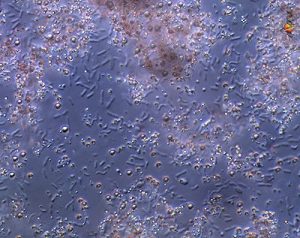Micro Organism
Microorganisms
A living organism that is very minute to be seen by the naked eye, especially a single celled organism, such as a bacterium is called microorganism. Microorganisms are classified into four major groups mainly bacteria, fungi, protozoa and some algae.
Some of the microorganisms are unicellular like bacteria, while some have well developed, multi-cellular body like moulds.
They can survive under different types of climatic environment, ranging from ice cold climate to hot summers and deserts to marshy, muddy lands. They are also found inside the bodies of animals including humans, air, water, soil, food and other things.
Free – living microorganisms :
Free-living microbes get their energy in many different ways. Some use photosynthesis, like plants do. Some break down natural chemicals in their environment. Others feed on things that were once living, such as fallen leaves and dead animals, causing them to breakdown or decay. Some fungi and bacteria cause food to decay. Moldy bread or fruit, sour milk, and rotten meat are examples of decayed food. In nature, decayed materials mix with soil, providing essential nutrients for plants to use. Without this process, the nutrients in the soil would run out. These types of organisms are called decomposers. They are the natural recyclers of living things on our planet.
Microbes also help us make some of our foods, such as bread, cheese, yogurt, beer, and wine. They feed on the sugar in grain, fruit, or milk, giving these foods a special texture and taste.
Parasitic microbes :
Some microbes, often called germs, cause illness or disease. They are parasites which live by invading living things. Chickenpox, mumps, and measles are all caused by viruses. They are infectious diseases. Certain bacteria cause tooth decay.It is possible to protect humans against some harmful microbes by storing and preparing food properly, cleaning the teeth, washing hands, and by avoiding close contact with ill people.
Types of Microorganism
Virus
They are much smaller and less complex than cells.
Viruses consist of either a strand of DNA or RNA enclosed in a protein coat called a Capsid.
Viruses do not grow.
They have no nucleus, cytoplasm or membranes.
Viruses do not carry out cellular functions.
They do not generate metabolic energy.
They are obligate intracellular parasites, meaning that they require a host cell to replicate.
Viruses can be virulent, which means harmful.
Some are temperate, meaning that they do not immediately cause disease.
Viruses play a role in causing some cancers.
Most viruses are very specific about the type of cell they invade. There are specific sites called receptor sites that the viruses attach to on the host cell’s surface.
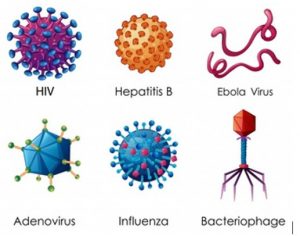
Bacteria
Bacteria are among the smallest of living organisms. They are unicellular (some Multicellular) or thalloid living organisms, sometimes with some differentiation of cells, but without differentiated tissues. Bacterial cells are prokaryotic possessing datively simple nucleus without any nucleus and nuclear membrane.
Some species of bacteria are parasites. They attack the living cells of other plants or of animals and secure their food from that source. But most bacteria grow as saprophytes on dead remains or the products of plant and animal life without a direct relationship with living cells.
Parasitic bacteria are responsible for some of the diseases of plants and animals, whereas, the saprophytic kinds may be beneficial in one way or the other.
While most of the bacteria are heterotrophic, a few are photosynthetic and chemosynthetic autotrophs and are capable of synthesizing carbohydrates out of carbon dioxide and water. Photosynthetic autotrophs contain photosynthetic pigment known as bacteriochlorophyll and can carry on a type of photosynthesis — photoautotrophic.
While others, lack such pigment, but can manufacture carbohydrates by chemosynthesis— chemoautotrophic.
More than 3,000 species of bacteria have been described in Bergey’s Manual. It is estimated that each person carries some 1014 bacteria, and that the total human population excretes from its collective gut 1022— 1023 bacteria per day.
Bacterial physical environments range from hot springs at 80°G to refrigerated foods, and from distilled water with trace contaminants to the Dead Sea.
Bacteria reproduce by binary fission. Some forms produce spores. Sexuality in bacteria is a very intriguing problem which is being thoroughly investigated. Transfer of genetic material from one cell to the other has, however, been reported in some bacteria. It has also been reported that bacteria maintain certain specific, inheritable attributes through countless series of cell generations.
They also possess some nuclear mechanism of inheritance. Both DNA and RNA are present in bacterial cells.
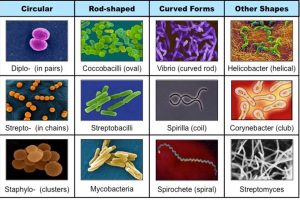
Fungi
Fungi (singular: fungus) are a kingdom of usually multicellular eukaryotic organisms that are heterotrophs (cannot make their own food) and have important roles in nutrient cycling in an ecosystem. Fungi reproduce both sexually and asexually, and they also have symbiotic associations with plants and bacteria. However, they are also responsible for some diseases in plants and animals. The study of fungi is known as mycology.
Some fungi are single-celled, while others are multicellular. Single-celled fungi are called yeast. Some fungi alternate between single-celled yeast and multicellular forms depending on what stage of the life cycle they are in. Fungi cells have a nucleus and organelles, like plant and animal cells do. The cell walls of fungi contain chitin, which is a hard substance also found in the exoskeletons of insects and arthropods such as crustaceans. They do not contain cellulose, which commonly makes up plant cell walls.
Multicellular fungi have many hyphae (singular: hypha), which are branching filaments. Hyphae have a tubular shape and are split into cell-like compartments by walls that are known as septa. These cells can have more than one nucleus, and nuclei and other organelles can move in between them. (There is some debate over whether multicellular fungi are truly multicellular, because organelles and cytoplasm can move from one cell to the other in a process called cytoplasmic streaming. They are commonly known as multicellular, but they are not multicellular in the same way as plants and animals, which have enclosed cells.) A fungus’s network of hyphae is called a mycelium.
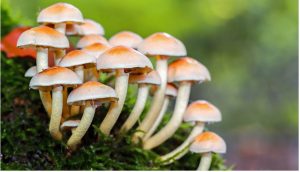
Algae
Algae are the simplest form of oxygen-producing plants and can grow in both fresh and salt water. Freshwater algae are of the blue-green and green varieties. Blue-green algae form the typical dark green scum on polluted or over fertilized water. Green algae occasionally form blooms on the surface, which float free or attach themselves to any solid object in the water. Although algae form the basic building block in the food chain in the water body, a great number of algae blooms make the water undesirable for swimming or drinking because of the discoloration or scum formed by the blooms. Odour from decomposing algae can also result in aesthetic problems. Algae control in lakes and ponds can be accomplished with copper sulphate or piquet. Copper sulphate has been used as a method of controlling algae.
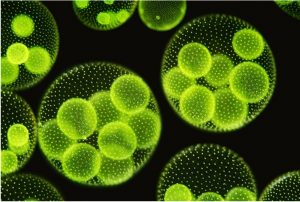
Protozoa
The group of organisms known as ‘protozoa’ are defined by a few of their shared characteristics. Protozoa are non-phototrophic, unicellular, eukaryotic microorganisms with no cell walls. This diverse group of over 65,000 species generally share these basic attributes. Looking deeper, this group can be extremely complex and variable. In fact, the protozoa are often described as the pinnacle of unicellular complexity.
Unlike the relatively simple bacteria, protozoa can have many different intracellular organelles performing specific tasks. Some species of protozoa have structures that are analogous to mouths, GI tracts, and anuses. This probably goes against everything you’ve been taught about microbes being simply bags of proteins and enzymes.
Many protozoa cause diseases in animals and humans. Some, like Plasmodium, which causes malaria, can be devastating to people worldwide. Others, like Trichomonas, cause sexually transmitted diseases that are relatively benign and 100% curable. The vast majority of the species, though, are completely harmless. But, as is usually the case in microbiology, it’s the dangerous ones that get the most attention.
EXAMPLES- Amoeba, Euglena ¸ Paramecium etc.
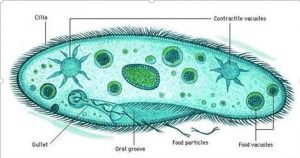
Archaea
Archaea are a domain of single-celled microorganisms. They have no cell nucleus or any other organelles inside their cells. In the past Archaea were classified as an unusual group of bacteria and named archaebacteria, but since the Archaea have an independent evolutionary history and manifest numerous differences in their biochemistry from other forms of life, they are now classified as a separate domain in the three-domain system. In this system the three primary branches of evolutionary descent are the Archaea, Eukarya and Bacteria. Archaea are further divided into four recognized phyla, although other phyla may exist. Of these groups the Crenarchaeota and the Euryarchaeota are most intensively studied. Classifying the archaea is somewhat challenging, since the vast majority have never been studied, and have chiefly been detected by analysis of their nucleic acids in samples from the environment.
